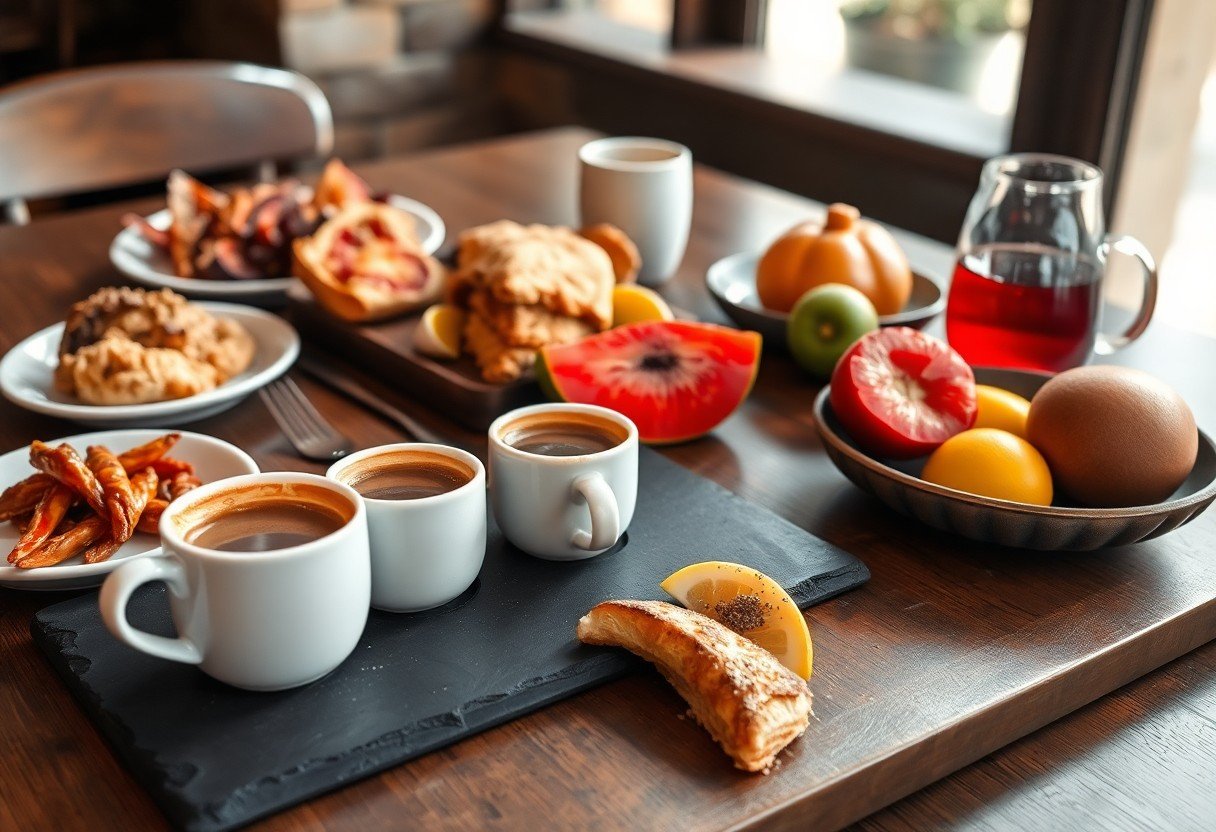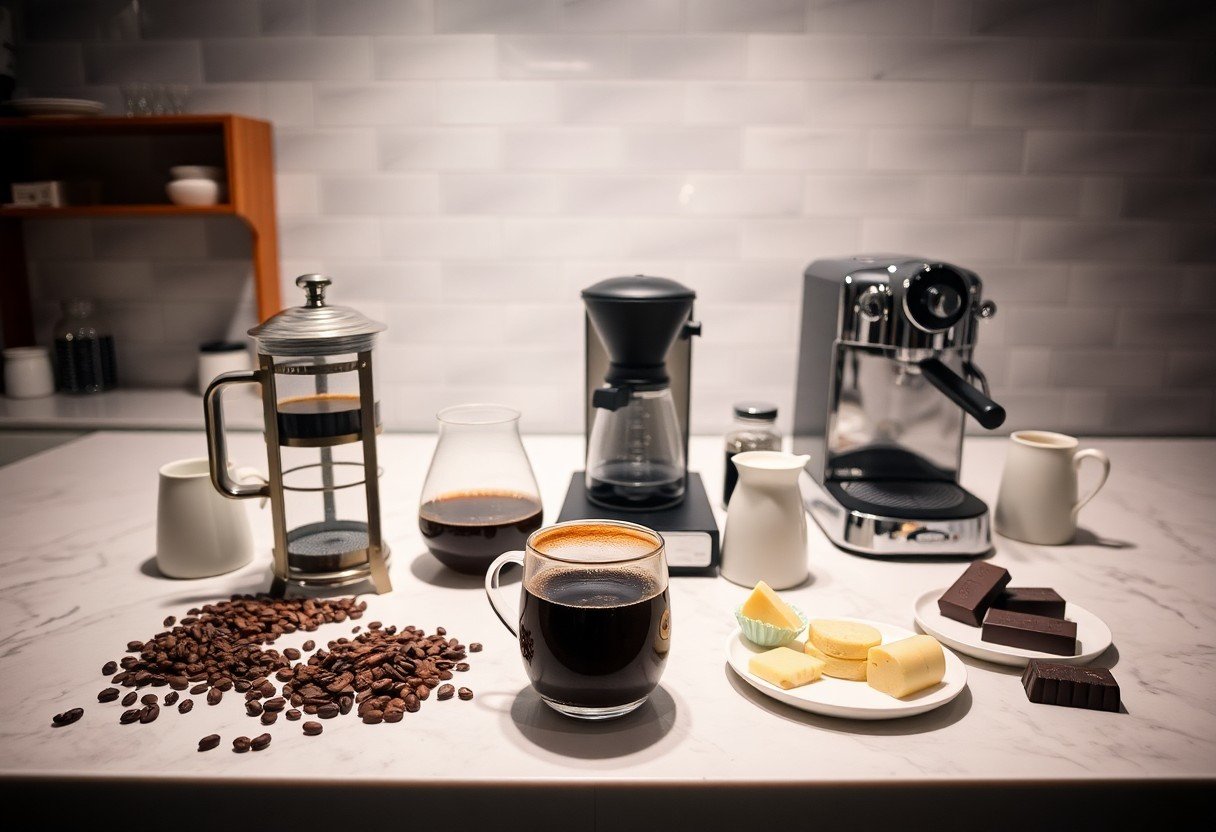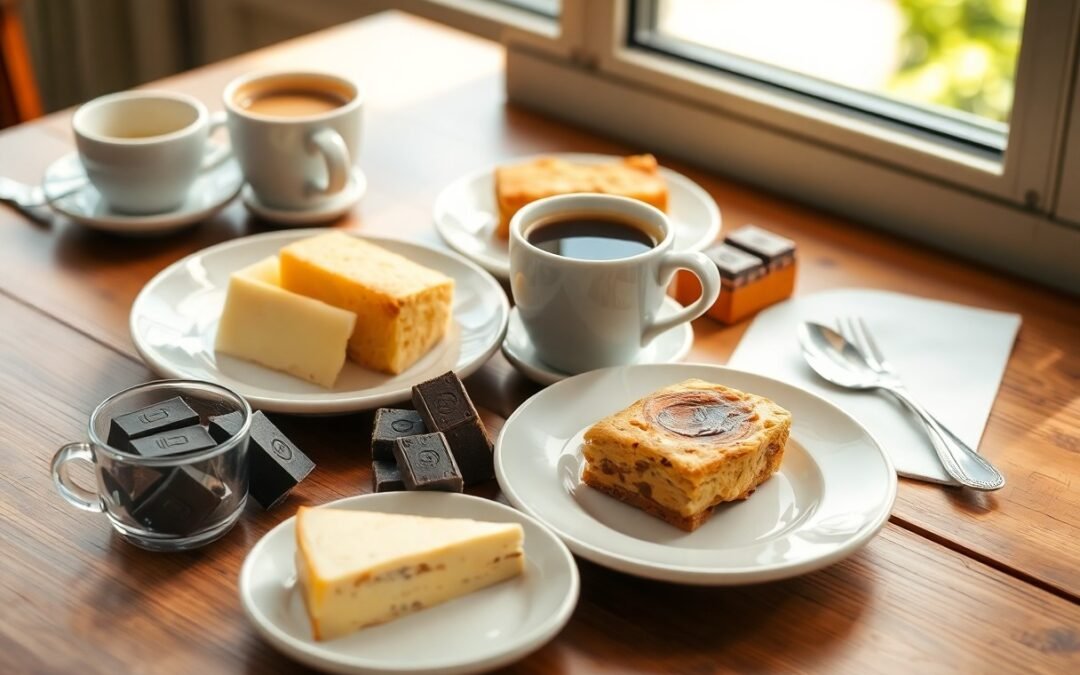You can elevate your dining experience by thoughtfully pairing food with the unique flavor profiles of artisan coffee. This guide will help you discover how different coffee notes—ranging from fruity to nutty—complement various dishes, enhancing both your palate and enjoyment. Whether you are a coffee enthusiast or simply looking to impress guests, these pairing insights will allow you to make informed choices that highlight the best in both food and coffee.
Unveiling Flavor Profiles: The Artisan Coffee Spectrum
Artisan coffee offers a diverse range of flavor profiles, each with unique characteristics that complement various food pairings. Understanding these flavors allows you to enhance your culinary experience, matching the right coffee to the right dish. From sweet and fruity to earthy and bitter, recognizing these profiles is imperative for creating memorable pairings that delight your palate.
The Sweetness Factor: Caramel and Fruity Notes
Caramel and fruity notes in artisan coffee provide a pleasant sweetness that pairs well with desserts and baked goods. You can indulge in this synergy by enjoying a light roast with notes of berries alongside a chocolate torte, or a medium roast with caramel undertones next to a slice of apple pie. The balance of sweetness enhances the flavors of both the coffee and your chosen dish.
The Earthy Depth: Nutty and Herbal Profiles
Nuts and herbs in coffee create a rich, grounding flavor that resonates beautifully with savory dishes. You might find that a medium roast with nutty notes matches perfectly with roasted vegetables, while herbal profiles can elevate a simple salad or a plate of cheese. This combination of flavors adds depth to your dining experience.
Nuttiness in coffee, often reminiscent of almonds or hazelnuts, brings warmth and richness that pairs seamlessly with hearty foods. Artisan coffees featuring herbal profiles may carry hints of chamomile or rosemary, which can elevate dishes like grilled meats or savory pastries. Seeking out these flavor nuances enables you to create dynamic combinations, transforming simple meals into gourmet experiences enhanced by complex coffee undertones. Experimenting with these pairings allows you to enhance the rich flavors of your food and deepen your appreciation of artisan coffee.
The Bitter Edge: Dark Roasts and Smoky Undertones
The bitter edge found in dark roasts and smoky undertones creates a bold flavor profile that complements robust dishes. Pairing a dark roast with smoked meats or barbecue enhances the smoky essence, while the bitterness can balance the richness of creamy sauces. You can enjoy this contrast to create complex and satisfying flavor experiences.
Dark roasts often present a depth that features dark chocolate, burnt sugar, or even hints of spice, making them ideal companions for rich foods. The bitterness in coffee will cut through the fat and richness of creamy cheeses or heavy meats. A smoky undertone can amplify the grilled flavor of steak or barbecue, creating a harmonious interaction on your palate. Delving into these pairings opens up a new world of flavor exploration and appreciation for both your food and coffee choices, ensuring a dining experience that lingers delightfully.
Complementary Pairings: Crafting Harmonious Taste Experiences
Creating complementary pairings with artisan coffee enhances the overall taste experience, inviting you to explore various flavor dimensions. Consider how the intricate notes of your coffee can elevate specific dishes, revealing unexpected nuances. By understanding the flavor profiles of both your coffee and food, you can establish harmonious connections that surprise and delight your palate.
Sweet Meets Sweet: Dessert and Coffee Synergy
Pairing desserts with coffee often leads to a delightful synergy where sweetness balances complex flavors. Rich chocolate, caramel, or fruit-based desserts can enhance the sweet notes found in your coffee while contrasting its acidity and body. A smooth dark roast complements dark chocolate cake beautifully, creating a lush treat for your taste buds.
Savory Pairings: Finding Common Ground with Brunch
Brunch provides an ideal opportunity for exploring savory food pairings with coffee. Dishes like fluffy omelets, hearty quiches, and spiced breakfast meats blend remarkably with medium-bodied coffees that carry nutty or herbal notes. These combinations allow the savory elements of your brunch to harmonize with the flavor intricacies of your chosen coffee.
As you investigate deeper into savory brunch pairings, consider placing your focus on how coffee’s distinct flavor notes can complement various ingredients. For instance, a bright Ethiopian coffee pairs excellently with herb-infused dishes, such as a goat cheese and spinach quiche, accentuating the savory herbs while cutting through the richness. On the other hand, a bold, dark roast can enliven spiced sausage links, balancing the dish’s richness with its intensity. This approach invites a captivating exploration of flavors that enhances your brunch experience.
Balancing Bitterness: Counteracting with Acidity
Balancing the bitterness of certain coffee blends is vital for a well-rounded taste experience. You can achieve this by pairing your coffee with foods that introduce bright acidity, such as citrus-infused dishes or pickled vegetables. This acidity cuts through the coffee’s naturally bitter notes, creating a more pleasing and harmonious flavor balance.
Incorporating acidic ingredients, such as a fresh arugula salad dressed with lemon vinaigrette, not only complements your coffee but also enhances the overall meal. For instance, a vibrant Colombian coffee, known for its bright acidity, pairs perfectly with a citrusy shrimp cocktail or grilled fish tacos topped with lime crema. The interaction between the dish and coffee softens bitterness, resulting in a refreshing dining experience that invites you to savor every bite and sip.

Cultural Influences: Regional Coffee Varieties and Cuisine
Your understanding of coffee flavors deepens when you consider regional influences. Each coffee origin carries unique characteristics shaped by local culture, cuisine, and agricultural practices. For instance, Ethiopian coffee, often fruity and floral, pairs well with tangy dishes, while rich Brazilian brews complement hearty meals. Recognizing these regional traits can enhance your coffee experience, allowing for thoughtful pairings that reflect the essence of their origins.
Coffee and Chocolate: A Divine Duo from Latin America
The marriage of coffee and chocolate is celebrated in Latin America, where both are deeply rooted in cultural heritage. The rich, earthy tones of coffee harmonize beautifully with the sweetness of dark chocolate, creating indulgent desserts or delightful beverages. Enjoy a cup of Guatemalan coffee alongside a piece of artisan dark chocolate for a perfect balance of flavors.
Spices and Brews: Middle Eastern Coffee with Culinary Flair
Middle Eastern coffee, often spiced with cardamom, cinnamon, or nutmeg, embodies rich traditions. These exotic spices enhance the coffee’s depth, making it an ideal accompaniment to savory pastries or sweet baklava. The warmth of the spices complements the robust coffee, offering a sensory experience that reflects the region’s vibrant culinary landscape.
Middle Eastern coffee rituals often include serving coffee alongside a variety of baked goods, enhancing flavor and aroma. Popular pairings involve pistachio-filled sweets or buttery croissants that contrast with the boldness of spiced brews. The lingering warmth of spices creates an inviting atmosphere, allowing you to savor not just the coffee but the entire experience of cultural richness in each sip.
Diverse Spirits: Pairing Coffee with Global Beverages
You can enhance your coffee experience by pairing it with diverse global spirits. Espresso mixed with Irish whiskey creates a classic Irish Coffee, while Italian Amaretto adds a sweet almond flavor that enhances your espresso’s profile. Exploring these combinations allows you to discover exciting new dimensions to your coffee palate.
This exploration of global spirit pairings invites you to mix textures and flavors, like using rum to elevate a dark roast coffee or enjoying the contrast of vodka and chilled brews. Each combination highlights different notes within the coffee, fostering a deeper appreciation for its complexities. Embrace these pairings for a captivating, multi-sensory experience that bridges cultures and enhances your coffee enjoyment.

The Art of Brewing: Techniques that Enhance Pairing Potential
Mastering brewing techniques directly influences your ability to pair artisan coffee with food. Each method extracts distinct flavor characteristics, allowing you to highlight the best attributes of your coffee and enhance the overall tasting experience. By understanding which brewing techniques bring out specific notes, you can create harmonious combinations that enrich your meals.
Brewing Methods: Choosing the Right Technique for Flavor
Selecting the appropriate brewing method significantly impacts coffee flavor profiles. Methods such as pour-over and French press tend to emphasize different notes. For instance, pour-over often highlights floral and fruity elements, while French press enhances body and richness. Experimenting with these methods can lead to delightful discoveries that complement your chosen dishes.
Temperature and Timing: Optimizing the Perfect Cup
The temperature of your water and the timing of extraction play critical roles in flavor development. Ideal brewing temperatures typically range from 195°F to 205°F, while steeping time varies based on your method—between 2-4 minutes for pour-over and around 4 minutes for French press. Adjusting these variables can unlock specific flavors tailored to your food pairings.
Temperature and Timing Optimization
| Temperature | Optimal brewing temperatures (195°F – 205°F) extract the best flavors while avoiding bitterness. |
| Timing | Steeping time varies by method: 2-4 minutes for pour-over, about 4 minutes for French press. |
Lower or higher temperatures can lead to under-extraction or bitterness, adversely affecting your coffee’s taste. Adjusting steeping times allows you to experiment with flavor profiles; for instance, a longer steeping time enhances the coffee’s body while risking over-extraction if not monitored closely. Balancing these factors is key to a well-rounded cup that pairs effectively with food.
Elevating the Experience: Creating a Tasting Menu
Designing a tasting menu around artisan coffee heightens the sensory experience, guiding your guests through a journey of flavors. Each course should complement and contrast the coffee selections, allowing for discovery and appreciation of both the food and coffee profiles. Consider incorporating small bites or dishes that emphasize the notes present in the coffee, thereby enhancing the overall tasting narrative while ensuring balance and harmony throughout the meal.
Curating the Coffee Flight: Selection and Sequence
Selecting a coffee flight involves careful consideration of flavor profiles and the sequence in which they are presented. Start with a lighter roast that showcases bright acidity and fruity flavors, then transition to medium-bodied coffees featuring nutty or chocolaty notes. Conclude with a bold, full-bodied option that offers deep, complex flavors. This thoughtful progression allows your palate to adapt and appreciate the diverse characteristics of each coffee.
Serving Suggestions: Presentation and Atmosphere
Crafting an inviting atmosphere and enhancing presentation can profoundly impact the tasting experience. Use elegant glassware or unique cups to serve coffee, ensuring that each vessel highlights its visual appeal. Create a serene environment with soft lighting and appropriate background music, allowing the focus to remain on the flavors. Consider serving small, curated bites alongside your coffees on polished wooden boards, creating an artisanal touch that reflects the quality of the ingredients.
Taking the time to enhance the serving environment transforms the tasting into an occasion. Incorporating seasonal elements like fresh flowers or artisanal bread adds warmth and depth to the experience. Use descriptive labels for each coffee to educate your guests, inviting them to engage more profoundly with the tasting. A well-thought-out presentation not only elevates the visual appeal but also sets the tone for a memorable culinary adventure, compelling your guests to savor each moment and flavor nuance. Aim for a cohesive narrative that intertwines the sensory elements, creating an unforgettable experience that champions both coffee and cuisine.
Conclusion
Conclusively, understanding the flavor profiles of artisan coffee enables you to create exceptional food pairings that enhance both your culinary experiences and coffee enjoyment. By exploring the unique notes of each coffee type, you can select complementary dishes that elevate your tasting journey. With this guide, you can confidently experiment with various combinations, transforming your coffee moments into memorable occasions while showcasing your palate’s sophistication.
FAQ
Q: What are the basic flavor profiles of artisan coffee?
A: Artisan coffee can have a range of flavor profiles including fruity, nutty, chocolatey, floral, and spicy notes. These flavors often depend on the coffee bean variety, origin, and roasting process.
Q: How can I pair fruity coffee with food?
A: Fruity coffee flavors pair well with desserts like pastries, fruit tarts, and chocolate-covered berries. They also complement light cheeses such as goat cheese or fresh salads with citrus dressings.
Q: What foods go well with chocolatey coffee?
A: Chocolatey coffee is best paired with rich desserts like brownies, chocolate cake, and dark chocolate. It also pairs nicely with roasted nuts and malty desserts like cookies and toffee.
Q: Can I pair spicy coffee with savory dishes?
A: Yes, spicy coffee flavors can enhance dishes with bold spices. They pair excellently with grilled meats, barbecued dishes, and savory stews, creating a balance between the flavors in the food and coffee.
Q: What is the best way to taste coffee’s flavor profile with food pairings?
A: The best way to taste coffee’s flavor profile is to brew a cup and then take small bites of the paired food. Alternate between sipping the coffee and eating the food to fully appreciate how the flavors interact and enhance each other.

